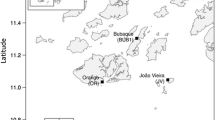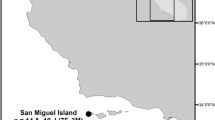Abstract
The effects of age on cadmium concentrations was investigated in Cory's shearwater, Calonectris diomedea, Lesser black-backed gull, Larus fuscus, and great skuas, Catharacta skua. There was no evidence for the continued accumulation of cadmium with increasing adult age. Adult shearwaters did have higher concentrations of cadmium compared to young fledglings, but there was no significant difference between cadmium concentrations in adult and sub-adult gulls. In addition, the sample of great skuas were of known age (3–22 yrs old) and showed no evidence of increasing cadmium concentrations with adult age in liver or kidney. However, it is possible that age accumulation of cadmium in great skuas was masked by individual dietary preferences overriding the effects of increasing age. It is often assumed that cadmium concentrations continue to accumulate with increasing adult age, but seabirds may have evolved some as yet unknown mechanism for excretion or more rapid turnover of cadmium than previously thought. The implications of this for the use of seabirds as biomonitors is discussed.
Similar content being viewed by others
References
Blomquist, S., Frank, A. and Petersson, L. R.: 1987, ‘Metals in Liver and Kidney Tissues of Autumn Migrating Dunlin, Calidris alpina and Curlew Sandpiper Calidris ferruginea Staging at the Baltic Sea’, Mar. Ecol. Prog. Ser. 35, 1–13.
Burger, J., Nisbet, I. C. T. and Gochfeld, M.: 1994, ‘Heavy metal and Selenium levels in feathers of known-aged common terns (Sterna hirundo)’, Arch. Environ. Contam. Toxicol. 26, 351–355.
Cramp, S.: 1983, Handbook of the Birds of Europe, the Middle East and North Africa Vol. 3: Wadersto Gulls, 801–815, Oxford University Press, Oxford.
Dietz, R., Born, E.W., Agger, C. T. and Neilsen, C.O.: 1995, ‘Zinc, Cadmium, Mercury and Selenium in polar bears (Ursus maritimus) from Central East Greenland’, Polar Biol. 15, 175–185.
Furness, R. W.: 1987, The Skuas, T. and A. D. Poyser (eds.), Calton.
Furness, R.W.: 1994, ‘An estimate of the quantity of squid consumed by seabirds in the eastern north Atlantic and ajoining seas’, Fish Res. 21, 165–177.
Furness, R. W. and Hutton, M.: 1979, ‘Pollutant levels in the Great Skua Catharacta skua’, Environ.Pollut. 19, 261–268.
Furness, R. W., Muirhead, S. J. and Woodburn, M.: 1986, ‘Using bird feathers to neasure mercury in the environment: Relationships between Mercury content and moult’, Mar. Pollut. Bull. 17, 27–30.
Gochfeld, M. and Burger, J.: 1987, ‘Factors affecting tissue distribution of heavy metals: Age effects and the metal concentration patterns in common terns Sterna hirundo’, Biol. Trac. Elem. Res. 12, 389–399.
Hutton, M.: 1981, ‘Accumulation of heavy metals and Selenium in three seabird species from the United Kingdom’, Environ. Pollut. (A) 26, 129–145.
Karlog, O., Elvestad, K. and Clausen, B.: 1983, ‘Heavy metals (Cadmium, Copper, Lead and Mercury) in common eiders Somateria mollissima, from Denmark’, Nord. Vet. Med. 35, 448–451.
Maegden, J. L., Hacker, C. S., Schroder, G. D. and Weir, F. W.: 1982, ‘Accumulation of Lead and Cadmium in the royal tern and sandwich tern’, Arch. Environ. Contam. Toxicol. 11, 99–102.
Nicholson, J. K.: 1981, ‘The comparative distribution of Zinc, Cadmium, and Mercury in selected tissues of the herring gull Larus argentatus’, Comp. Biochem. Physiol. 68C, 91–94.
Osborn, D., Harris, M. P. and Nicholson, J. K.: 1979, ‘Comparative tissue distribution of Mercury, Cadmium, and Zinc in three species of pelagic seabirds’, Comp. Biochem. Physiol. 64C, 61–67.
Paludan-Müller, P., Agger, C. T., Dietz, R. and Kinze C. C.: 1993, ‘Mercury, Cadmium, Zinc, Copper and Selenium in harbour propoise (Phocoena phocoena) from West Greenland’, Polar Biol. 13, 311–320.
Reid, M. and Hacker, C. S.: 1982, ‘Spacial and temporal variation in Lead and Cadmium in the laughing gull, Larus atricilla’, Mar. Poll. Bull. 13, 387–389.
Renzoni, A., Focardi, S., Fossi, C., Leonzio, C. and Mayol, J.: 1986, ‘Comparison between concentrations of mercury and other contaminants in eggs and tissues of Cory's shearwater Calonectrisdiomedea collected on Atlantic and Mediterranean islands’, Environ. Pollut. 40, 17–35.
Scheuhammer, A. M.: 1987, ‘The chronic toxicity of Aluminium, Cadmium, Mercury and Lead in birds: A Review’, Environ. Poll. 46, 263–295.
Stewart, F. M., Thompson., D. R., Furness, R. W. and Harrison, N.: 1994, ‘Seasonal variation in heavy metal levels in tissues of common guillemots, Uria aalge from North-West Scotland’, Arch. Environ. Contam Toxicol. 27, 168–178.
Stewart, F. M., Furness, R. W. and Monteiro, L. R.: 1996, ‘Relationships between heavy metal and metallothionein concentrations in lesser black-backed gulls, Larus fuscus, and Cory's shearwater Calonectris diomedea’, Arch. Environ. Contam. Toxicol. 30, 299–305.
Stewart, F. M., Monteiro, L. R. and Furness, R. W.: 1997, 'Heavy metal concentrations in Cory's shearwater Calonectris diomedea, from the Azores, Portugal, Bull. Environ. Contam. Toxicol. 58, 115–122.
Stock, M., Herber, R. F. M. and Geron, H. M. A.: 1989, ‘Cadmiumlevels in oystercatcher Haematopusostralegus from the German Waddensea’, Mar. Ecol. Prog. Ser. 53, 227–234.
Thompson, D. R.: 1990, ‘Metal Levels in Marine Vertebrates’, in: Furness, R.W. and Rainbow, P. S. (eds.), Heavy Metals in the Marine Environment, CRC Press, Boca Raton., FL, Ch. 9, 143–182.
Torra, M., To-Figueras, J., Brunet, M., Rodamilans, M. and Corbella, J.: 1994, ‘Total and metallothionein-bound cadmium in the liver and kidney of a population in Barcelona (Spain)’, Bull. Environ. Contam. Toxicol. 53, 509–515.
Walsh, P.: 1990, ‘The Use of Seabirds as Monitors of Heavy Metals in the Marine Environment’, in: Furness, R. W. and Rainbow, P. S. (eds.), Heavy Metals in the Marine Environment, CRC Press, Boca Raton, FL, Ch. 10, 183–204.
Wenzel, C. and Gabrielsen, G. W.: 1995, ‘Trace element accumulation in three seabird species from Hornoya, Norway’, Arch. Environ. Contam. Toxicol. 29, 198–206.
Wolkers, H., Wensing, T., Geert, W. T. A. and Bruinderink, G.: 1994, ‘Heavy metal contamination in organs of red deer (Cervus Elaphus) and wild boar (Sus scrofa) and the effect on some trace elements’, Sci. Tot. Environ. 144, 191–199.
Author information
Authors and Affiliations
Rights and permissions
About this article
Cite this article
Stewart, F.M., Furness, R.W. The Influence of Age on Cadmium Concentrations in Seabirds. Environ Monit Assess 50, 159–171 (1998). https://doi.org/10.1023/A:1005764008119
Issue Date:
DOI: https://doi.org/10.1023/A:1005764008119




